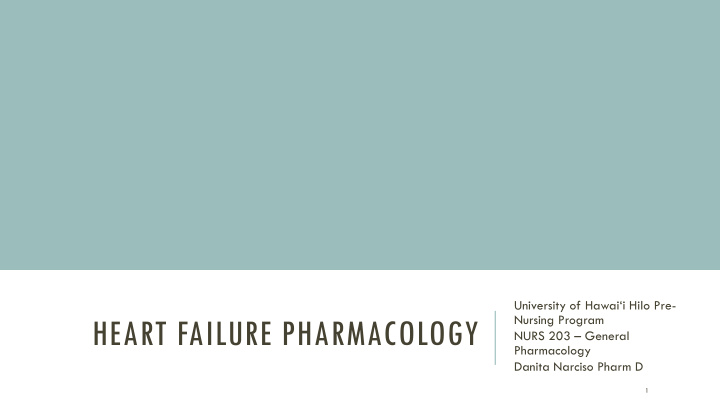



University of Hawai‘i Hilo Pre - Nursing Program HEART FAILURE PHARMACOLOGY NURS 203 – General Pharmacology Danita Narciso Pharm D 1
LEARNING OBJECTIVES Understand the effects of heart failure in the body Understand how one gets heart failure Understand how each of the medications work to relive the symptoms of heart failure Know which medications help prevent cardiac remodeling Know digoxin and nesiritide 2
WHAT IS HEART FAILURE - WHEN THE VENTRICLES CANNOT PUMP OUT ENOUGH BLOOD TO MEET THE DEMANDS OF THE BODY Diastolic Systolic Ventricular filling (enlargement/stiffness) Ventricular pumping (contractility)/ejection) Right sided Left sided Back up of blood into the venous system Back up of blood into the pulmonary system 3
RISK FACTORS FOR HEART FAILURE 4
WHAT CAUSES HEART FAILURE? Diastolic *PRESERVED EF Systolic *DECREASED EF Increased ventricular stiffness Damaged or reduced heart muscle (MI) Mitral or tricuspid valve stenosis Dilated cardiomyopathy Pericardial disease Ventricular hypertrophy Pressure overload Volume overload Usually from prolonged uncontrolled hypertension Ischemic heart disease (MI) Uncontrolled risk factors 5
WHAT HEART FAILURE CAUSES 6
THE HEART TRIES TO COMPENSATE 7
PROBLEMS ASSOCIATED WITH HEART FAILURE Remodeling Refers to the structural damage that can take place in the heart after prolonged stress Chamber dilation, fibrosis, abnormal cells, reduction in cardiac muscle cells Compensation Your body’s attempt to make up for the lack of oxygen and nutrients to the tissues Decompensation When your body cannot fill the void any longer 8
STRATEGIES FOR TREATING HEART FAILURE Reduce Preload Reduce Afterload • Venous return of blood to • Reduce Heart Rate Arteries the heart • • Regulate SNS Regulate SNS • Blood volume • RAAS • RAAS 9
10
ACEI & ARBS PREVENT/REVERSE REDUCE PRELOAD REDUCE AFTERLOAD REMODELING • • • Reduced aldosterone release Relaxation of arterial smooth Decrease in SNS tone • • Dilate veins (long-term use muscle EPI causes fibrotic effect) processes in the heart • Angiotensin II receptors in the heart cause hypertrophy • Angiotensin I receptors in the heart ACEI ARB 11
BETA BLOCKERS Three beta blockers have been studied to show decrease in morbidity and mortality with their use in heart failure Metoprolol succinate How BB work in HF ADRs Cavedilol • • Caution – may reduce cardiac Bronchial constriction Bisoprolol • output Reduced cardiac output • Decreased concentrations of • Ventricular failure • catecholamines Fatigue • • Upregulation of beta Reduced exercise tolerance • receptors Unpleasant dreams, insomnia, • Decrease heart rate depression • Decreased hypertrophy & • Deleterious effect on lipid panel • remodeling Withdrawal - taper 12
DIURETICS Thiazide Loop PS • • • Mild HF Marked fluid retention Adjunct • • Edema of lungs & Increase diuresis • limbs Correct electrolyte imbalance Potassium Sparing Therapeutic effects in HF treatment (thiazide & • Reduce morbidity & loops) mortality • Reduce preload • Reduction in aldosterone • Reduced blood volume action • Reduce cardiac size • All with mod/severe HF 13
DIGOXIN Increase the refractory period – negative chronotropic Are from PSN effects Decrease conduction velocity – negative dromotropic Increase contractility of the heart – positive inotropic Next slide 14
DIGOXIN Increase contractility of the heart – positive inotropic 3 1. The Na/K ATPase pump moves Na against 2 its concentration gradient outside the cell 2. A Ca/Na exchanger allows Na to flow into 1 the cell, in exchange for a calcium (driven by concentration gradient) 3. This creates a charge gradient and maintains a concentration gradient for Ca to follow • Sodium UNDER NORMAL CIRCUMSTANCES Potassium Calcium 15
DIGOXIN Increase contractility of the heart – positive inotropic 3 UNDER NORMAL CIRCUMSTANCES 2 1 1. The Na/K ATPase pump is inhibited 2. Less Ca is lost in the Ca/Na exchanger 3. Ca still moves in • Sodium the cell – higher Potassium Ca levels are Calcium maintained WITH DIGOXIN 16
DIGOXIN – NARROW THERAPEUTIC WINDOW Kinetics ADRs • At high/toxic doses, SNS outflow • 65-80% bioavailability • Arrhythmia – too much calcium in heart • Distributes well, CNS • Bigeminy • Excreted unchanged by kidneys • AV block • Dose adjust • Ventricular tachycardia • Ventricular fibrillation • Diarrhea & vomiting • CNS – Halos, disorientation & hallucinations 17
DIGOXIN – EXTRA BEATS Too much calcium Delayed after depolarization Potassium increase = more positive resting membrane potential Normal sinus rhythm Premature Ventricular Beats (PVB) - bigeminy 18
DIGOXIN – DRUG INTERACTIONS Digoxin interacts with the following substances: Potassium Hyperkalemia – decreases the effects of digoxin Hypokalemia – Increases he effects of digoxin Thiazide and loop diuretics Cause hypokalemia Potassium sparing diuretics Cause hyperkalemia Calcium supplementation Magnesium supplementation Antidote = Potassium or anti-digoxin antibody 19
DIGOXIN – DIGIFAB CALCULATIONS Page 514 in your book 20
HYDRALAZINE - VASODILATOR Therapeutic effects ADRs Dilated arteries (reduce afterload) Headache Reduce remodeling – long-term effect Nausea Increase cardiac output Palpitations Used in patients with Lupus like symptoms High peripheral vascular resistance Arthralgia, myalgia, skin rash Low ventricular output Fever Peripheral neuropathy 21
NITRATES- ISOSORBIDE DINITRATE Therapeutic effects ADRs Dilated veins(reduce preload) Headache Reduce remodeling – long-term effect Orthostatic hypotension Used in patients with: Tachycardia High ventricular filling pressure Pulmonary congestion & SOB 22
NESIRITIDE Non-selective dilation of vessels Brain Natriuretic Peptide (BNP) What is BNP Substances released in HF patients to attempt to balance the activation of the RAAS system What does BNP (with ANP in the body) do? Natriuresis Diuresis Vasodilation Decreased aldosterone Decreased hypertrophy Inhibition of SNS and RAAS 23
NISIRITIDE Uses/ADRs Kinetics Uses: Used as continuous IV infusion – very short half life Reduce preload and afterload Acute decompensated heart failure Metabolized by vascular enzymes and excreted in the urine ADRs: Severe hypotension Ventricular arrhythmias Renal damage 24
QUESTIONS 25
Recommend
More recommend